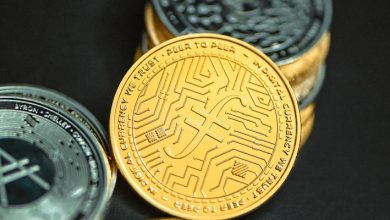The Rise of Layer 2 Tokens: What You Need to Know

- Understanding Layer 2 solutions in blockchain
- Exploring the benefits of Layer 2 tokens
- Comparing Layer 2 tokens to traditional cryptocurrencies
- Key considerations before investing in Layer 2 tokens
- The future of Layer 2 tokens in the crypto market
- How Layer 2 tokens are revolutionizing decentralized finance
Understanding Layer 2 solutions in blockchain
Layer 2 solutions in blockchain refer to protocols or mechanisms built on top of an existing blockchain network, such as Ethereum, to improve scalability and reduce transaction costs. These solutions aim to address the limitations of the underlying blockchain technology by offloading some of the processing work to secondary layers.
One of the key advantages of layer 2 solutions is that they can significantly increase the transaction throughput of a blockchain network. By moving some of the transaction processing off-chain, layer 2 solutions can handle a much higher volume of transactions compared to the base layer. This can help alleviate issues such as network congestion and high fees that are often associated with popular blockchain networks.
Another benefit of layer 2 solutions is their ability to enhance the user experience. By reducing transaction costs and increasing speed, layer 2 solutions make it more practical for users to interact with decentralized applications (dApps) and make microtransactions. This can help drive adoption of blockchain technology and make it more accessible to a wider audience.
Some examples of layer 2 solutions include payment channels, sidechains, and state channels. Payment channels, such as the Lightning Network for Bitcoin, allow users to conduct off-chain transactions that are later settled on the main blockchain. Sidechains are separate blockchains that are interoperable with the main blockchain, enabling faster and cheaper transactions. State channels, like those used in the Raiden Network for Ethereum, allow users to interact off-chain while retaining the security guarantees of the main blockchain.
In conclusion, understanding layer 2 solutions in blockchain is crucial for anyone looking to fully grasp the potential of blockchain technology. By leveraging these solutions, developers and users can enjoy improved scalability, reduced costs, and a better overall user experience. As blockchain technology continues to evolve, layer 2 solutions will play an increasingly important role in shaping the future of decentralized applications and cryptocurrencies.
Exploring the benefits of Layer 2 tokens
Layer 2 tokens offer a wide range of benefits that make them an attractive option for users and developers alike. One of the key advantages of Layer 2 tokens is their ability to significantly reduce transaction costs and increase transaction speeds. By moving transactions off the main blockchain and onto a secondary layer, Layer 2 tokens can process transactions more quickly and efficiently, resulting in lower fees for users.
Additionally, Layer 2 tokens can help to alleviate some of the scalability issues that have plagued many popular blockchains. By offloading a portion of the transaction volume to a secondary layer, Layer 2 tokens can help to reduce congestion on the main blockchain, allowing for more seamless and reliable transactions.
Another benefit of Layer 2 tokens is their ability to support a wide range of use cases and applications. From decentralized finance (DeFi) platforms to non-fungible tokens (NFTs) and gaming applications, Layer 2 tokens offer a versatile solution for developers looking to build innovative new projects.
Overall, the rise of Layer 2 tokens represents an exciting development in the world of blockchain technology. With their ability to reduce costs, increase speeds, and support a wide range of use cases, Layer 2 tokens are poised to play a key role in the future of decentralized applications.
Comparing Layer 2 tokens to traditional cryptocurrencies
When comparing Layer 2 tokens to traditional cryptocurrencies, it is essential to understand the key differences between the two. Layer 2 tokens are built on top of existing blockchain networks, such as Ethereum, to improve scalability and transaction speeds. Traditional cryptocurrencies, on the other hand, operate on the base layer of a blockchain network, which can lead to network congestion and high fees during times of high demand.
Layer 2 tokens utilize off-chain solutions to process transactions more efficiently, reducing the burden on the main blockchain network. This allows for faster transaction times and lower fees compared to traditional cryptocurrencies. Additionally, Layer 2 tokens can support a higher volume of transactions per second, making them more suitable for use in decentralized applications and other high-throughput use cases.
In contrast, traditional cryptocurrencies rely solely on the base layer of the blockchain network to process transactions, which can lead to slower confirmation times and higher fees. This can be a significant barrier to adoption for mainstream users who are accustomed to fast and inexpensive transactions. Layer 2 tokens offer a solution to these issues by providing a more efficient and scalable alternative to traditional cryptocurrencies.
Overall, Layer 2 tokens represent an exciting development in the cryptocurrency space, offering a more efficient and scalable solution for processing transactions. By leveraging off-chain solutions, Layer 2 tokens can provide faster transaction times, lower fees, and greater scalability compared to traditional cryptocurrencies. As the demand for fast and inexpensive transactions continues to grow, Layer 2 tokens are poised to play a significant role in shaping the future of decentralized finance and other blockchain-based applications.
Key considerations before investing in Layer 2 tokens
Investing in Layer 2 tokens can be an exciting opportunity, but it’s important to consider a few key factors before diving in. One crucial consideration is the scalability of the Layer 2 solution you are looking to invest in. Make sure to research how well the token’s Layer 2 technology can handle a high volume of transactions and if it can effectively reduce congestion on the main blockchain network.
Another important factor to keep in mind is the security of the Layer 2 solution. Look into the token’s security features and protocols to ensure that your investments are protected from potential threats. It’s essential to prioritize tokens that have strong security measures in place to safeguard your assets.
Additionally, consider the team behind the Layer 2 project. Research the developers, advisors, and overall team to assess their experience and credibility in the blockchain space. A strong and reputable team can significantly impact the success and longevity of a Layer 2 token.
Furthermore, analyze the tokenomics of the Layer 2 project. Evaluate the token’s supply, distribution, and utility to determine its long-term potential for growth and value appreciation. Understanding the tokenomics can give you valuable insights into the token’s economic model and its sustainability.
Lastly, consider the adoption and use cases of the Layer 2 token. Research the partnerships, collaborations, and real-world applications of the token to gauge its potential for widespread adoption and utility. A token that has a clear use case and is being actively adopted by users and businesses is more likely to succeed in the long run.
By carefully considering these key factors before investing in Layer 2 tokens, you can make more informed decisions and mitigate potential risks. Remember to conduct thorough research and due diligence to ensure that your investments align with your financial goals and risk tolerance.
The future of Layer 2 tokens in the crypto market
Layer 2 tokens are gaining momentum in the crypto market as they offer solutions to the scalability issues faced by many blockchain networks. These tokens operate on top of existing blockchains, enabling faster and cheaper transactions compared to on-chain transactions. This increased efficiency is attracting more users and developers to explore the potential of Layer 2 solutions.
One of the key advantages of Layer 2 tokens is their ability to enhance the overall user experience by reducing transaction fees and wait times. This makes them an attractive option for decentralized applications (dApps) looking to improve their scalability and usability. As a result, we can expect to see an increasing number of projects incorporating Layer 2 solutions into their ecosystems in the near future.
Moreover, the future of Layer 2 tokens in the crypto market looks promising as more developers are working on innovative solutions to further enhance the capabilities of these tokens. With ongoing research and development efforts, we can anticipate the introduction of new features and functionalities that will make Layer 2 tokens even more competitive in the market.
Overall, the rise of Layer 2 tokens signifies a significant step towards achieving mass adoption of blockchain technology. As more projects leverage these solutions to improve scalability and user experience, we can expect to see a more efficient and user-friendly crypto market in the coming years.
How Layer 2 tokens are revolutionizing decentralized finance
Layer 2 tokens are making waves in the world of decentralized finance (DeFi) by offering solutions to the scalability and high transaction fees associated with Layer 1 blockchains like Ethereum. These tokens are built on top of existing blockchains, providing a way to process transactions off-chain before settling them on the main blockchain. This approach significantly reduces congestion and costs while maintaining security and decentralization.
One of the key benefits of Layer 2 tokens is their ability to increase transaction speeds, enabling more efficient and seamless DeFi applications. By moving transactions off-chain, users can enjoy near-instant confirmations and lower fees, making decentralized finance more accessible to a wider audience. Additionally, Layer 2 tokens can support a higher volume of transactions, further improving the scalability of DeFi platforms.
Another advantage of Layer 2 tokens is their interoperability with other Layer 1 and Layer 2 solutions. This means that users can easily transfer assets between different blockchains and scaling solutions, enhancing the overall efficiency and usability of the decentralized finance ecosystem. With interoperability, users can take advantage of the unique features and benefits offered by various Layer 2 tokens, creating a more versatile and robust DeFi landscape.
Overall, Layer 2 tokens are revolutionizing decentralized finance by addressing the scalability and cost challenges that have hindered the growth of the industry. With faster transaction speeds, lower fees, and enhanced interoperability, these tokens are paving the way for a more accessible, efficient, and interconnected DeFi ecosystem. As the demand for decentralized finance continues to grow, Layer 2 tokens are poised to play a significant role in shaping the future of financial innovation.



